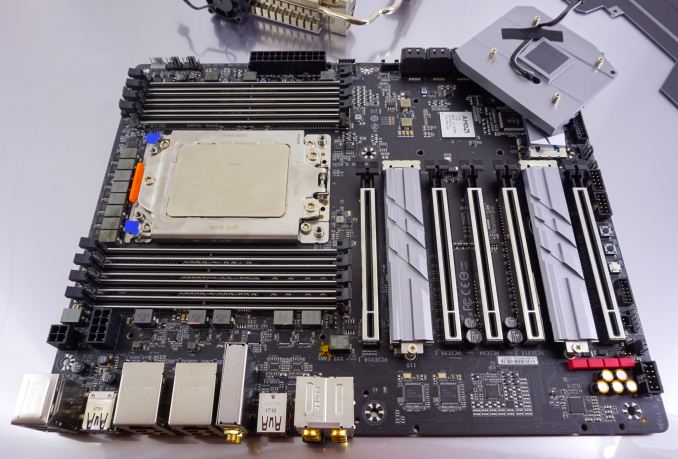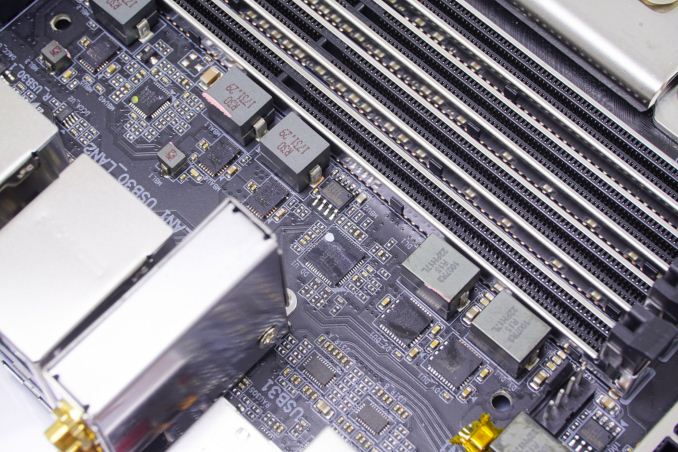The GIGABYTE X399 DESIGNARE EX Motherboard Review
by E. Fylladitakis on June 22, 2018 11:30 AM EST- Posted in
- Motherboards
- Gigabyte
- ASRock
- Asus
- Ryzen
- ThreadRipper
- X399
- 1950X
Conclusion
The GIGABYTE X399 Designare EX is the best AMD X399 motherboard that the company has to offer. Rather than focusing on gamers, like the GIGABYTE X399 Gamng 7, the X399 Designare EX is a product vaguely targeting advanced professionals, with the Designare focusing on the implementation's reliability and rigidity. The options that would appeal to gamers and modders are available, ranging from RGB lighting and RGB strip headers to a good power circuitry, and from plenty of thermal control options to versatile overclocking capabilities (that the marketing team graciously avoids to even mention publicly), yet GIGABYTE is focusing their marketing efforts almost exclusively on the motherboard's features and reliability.
The layout of the X399 Designare EX is very cleverly organized and its thermal design is more than capable for typical use and mild overclocking. Its power circuitry is very well designed, with excellent quality components and ingeniously applied control. For a system running at stock settings or mildly overclocked, the X399 Designare EX will operate both efficiently and reliably. However, the lack of additional power connectors will likely limit the motherboard's overclocking capabilities, especially when multiple GPUs are installed. We find it quite unlikely that the motherboard will be able to handle the power requirements for three or four high-end graphics cards if the user tries to overclock all of them at once.
For performance, while GIGABYTE does apply some additional 'above stock' frequency with a default BIOS, most other boards do as well so it was par for the course in our performance tests. System level tests were a little different, with the Designare EX being very good power wise at Idle, and giving the best POST time of any of our X399 motherboards. DPC Latency was a little lacking however, which suggests that the board might need additional tuning to be an audio focused workstation, but is certainly sufficient for almost everyone else.
GIGABYTE chose the subsystems of the X399 Designare EX clearly with reliability in mind. The board uses the long-proven Intel I211-AT network controllers, which may not the fastest but they are definitely one of the most stable Gigabit LAN chipsets ever made. GIGABYTE did not install a 5/10 Gbit chipset on the X399 Designare EX as there is no support or demand for it right now, opting for a lower retail price over a currently not-so-popular feature, suggesting users nuy an add-in card if needed. The sound circuitry is very good, based on the Realtek ALC1220 chipset and designed with excellent quality components. Realtek's chipset is one of the best currently available and Sound Blaster's X 720° software improves it even further, forming a very solid audio solution for a high-end PC.
One thing that stands out about the X399 Designare EX is the sheer number of USB ports. There are eight USB 3.1 Gen 1 ports at the rear panel, plus the Type-A/Type-C USB 3.1 Gen 2 ports. However, there is only one header for up to two front panel USB 3.1 Gen 1 ports, plus another header for a single Type-C front panel port. Again, note that the front panel Type-C port header is limited to 5 Gbps. Two USB 3.1 Gen 1 ports are not enough for several high-end cases that have four front panel ports but at least the X399 Designare EX also has two USB 2.0 headers for up to four USB 2.0 front panel ports.
On the topic of storage, the X399 Designare EX supports up to eight SATA drives and up to three M.2 drives, with two M.2 slots supporting drives up to 110 mm. All three M.2 slots can allocate up to four PCIe lanes each, as no lanes are shared on the X399 Designare EX. GIGABYTE also is the a manufacturer that offers a pre-installed cooling solution for M.2 drives.
Weighing all of its features and considering its target group, the GIGABYTE X399 Designare EX is an excellent motherboard for both home users and workstations. It is a fast motherboard that is very well designed overall, with good subsystems, a clever layout, and reliable components. Although the options are there, it is clearly not a motherboard designed for extreme overclocking, yet it offers good versatility for the typical overclocker that will use conventional cooling systems. The omission of a 10G LAN chipset is apparent when comparing this board to its competition but so is the price difference, with the X399 Designare EX currently retailing at $371, a significantly lower price than that of every other manufacturer's top offering.
AnandTech's AMD Ryzen Threadripper and X399 Motherboard Coverage
- The AMD Ryzen Threadripper 1950X and 1920X Review: CPUs on Steroids
- An AMD Threadripper X399 Motherboard Overview
- Analyzing Threadripper Thermals: Big Base Cooling Wins
- AMD Reveals Threadripper 2 : Up to 32 Cores, 250W, X399 Refresh
- GIGABYTE’s X399 Aorus Extreme: The Threadripper 2 Halo Motherboard
- New EKWB Threadripper X399 Monoblocks for GIGABYTE and MSI












20 Comments
View All Comments
Oxford Guy - Sunday, June 24, 2018 - link
I agree. When TR 2 hits I would highly recommend Anandtech do an "undervolting Threadripper" page that compares Gen 2 an Gen 1 — on multiple boards.And, since this is a pro product, the overclocking stability threshold needs to ensure real stability, not the quick and dirty standard.
ECC RAM would also be useful to look at, when analyzing TR 2.
azrael- - Wednesday, June 27, 2018 - link
I was just going to point out that one of the foremost features on what is a semiprofessional motherboard for AMD's ThreadRipper should be support for ECC memory and the subsequent test thereof. Luckily, as far as Gigabyte's specification table goes the motherboard *does* support ECC memory. Now AT only needs to test it.Tom S - Monday, February 24, 2020 - link
I know that this is not a conclusive test, but with my X399 Designare EX...I have 4X16GB sticks of Kingston KSM26ED8/16ME - 2666GHz - ECC - CL19 - 1.2V
When I OC'd the memory to 3600MHz @ 1.2V with very tight timings (I forget exactly what)
it threw an ECC error that was captured by Memtest86.
Other ECC boards I've owned, have reported ECC errors in Windows event log "Kernal-WHEA",
or another log viewable in BIOS.
hansmuff - Saturday, June 23, 2018 - link
Which program did you use for measuring DPC? There are a few different ones, and I find they all produce different results.CEH - Monday, June 25, 2018 - link
You seem a bit obsessed with AMD lately. Isn't there anything interesting in Intel-related boards?oleyska - Tuesday, June 26, 2018 - link
I'll throw this out there:No..
Z170->270->Z370 is similar with minor updates to bling and the vrm circuit but nothing exciting.
X299 apart from evga's isn't very interesting.
The thing that makes x399 very exciting is the 64(60) pci-e lanes exposed to board manufactures while Intel have been giving 20,28,44 forever!
crashtech - Tuesday, June 26, 2018 - link
Flash drive instead of DVD should really be doable at this price level for sure.zukefok - Wednesday, June 27, 2018 - link
A quick glance at the motherboard's specifications reveals that up to eight SATA drives and three M.2 drives can be connected on the GIGABYTE X399 Designare EXvirpuain@gmail.com - Sunday, July 15, 2018 - link
"The second important feature of the GIGABYTE X399 Designare EX is the implementation of an International Rectifier IR35201 digital controller. What is unique about this particular controller is that it implements an algorithm that balances the load (and the heat output) across all of the power phases. This means that instead of having a couple of stages heavily loaded all of the time while the rest are idling, all eight stages are continuously sharing about the same load, greatly increasing the longevity of the circuitry. This means that the motherboard should hold up well for the upcoming Threadripper 2 launch."The IR35201 is not the reason any board will fulfill the power delivery needs ofa TR2, fets and phases will.
That being said, eight real phase consisting of the IR3556 is subpar VRM for a motherboard that needs to handle cpus at the 200W range. Board is pricey, in fact the VRM on this board is weaker than what you have on the flagship AM4 boards, like the taichi or ASUS CVII.
Tom S - Monday, February 24, 2020 - link
Did you run this with a special BIOS?I am trying to enter an offset voltage, but my BIOS F12, and every reviewer post that I've seen
seems to have Dynamic Vcore(DVID) and Dynamic VCORE(DVID) for SOC grayed out.
Is there some other field that I need to set in order to enter a value here? Help someone, thanks.